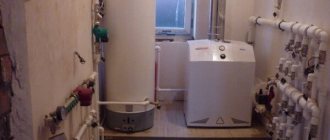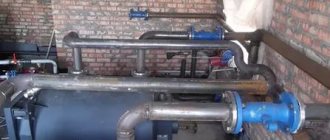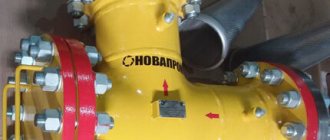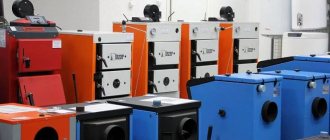The house has a gas boiler AOGV Siberia 17.4 with Eurosit 630 automation. A week ago it had a malfunction. The unit begins to fade as soon as the wind flow hits the ignition device. Not long ago I changed the thermocouple, but nothing changed. How to fix?
When the main burner turns on, this leads to a decrease in the supply of fuel to the ignition burner, which means that the automation is activated. You need to add fuel to the ignition mechanism. This happens mainly due to a drop in pressure in the heating system. In another case, the draft in the chimney weakened if it was installed incorrectly.
Tell me what the problem is if this device turns off, especially when there are strong gusts of wind and rainy weather outside. How should the problem be resolved?
When the igniter is started, the solenoid valve is forced to operate in approximately 20 seconds. When the ignition wick goes out, the solenoid valve turns off within ten seconds and a click will be heard.
Four years ago I installed an AOGV 17.4 Siberia boiler at the dacha. The house is small, area no more than 40 square meters. As you can see, the flow rate is small, but the water cannot heat up above 55 degrees. We have 2 radiators for 12 sections. Can't figure out how to increase the heating temperature?
To fix the problem, install a circulation pump. Sometimes there is a decrease in pressure in the gas line.
What causes the boiler to overheat systematically during use?
The main factor is that circulation in the heating circuit has stopped. It is also possible that the filter is clogged or there is an excessive amount of air in the heating system.
We have a problem. When we close the cold tap and open the hot water tap, water comes out of the heating system. What's happening?
Apparently your heating system feed tap is faulty. It allows water to move through both pipelines. If there is water pressure in the system, then movement in the opposite direction should not occur.
Why does the device make noise, gurgle, and at times howl and even clap?
The liquid in the system is very enriched with oxygen. When heated, air evaporates, which causes noise. If the unit settings are incorrect, the gas valve or bypass may howl. Strong pops during startup indicate problems with the ignition mechanism.
At the end of 2014, we installed the AOGV Siberia 11.6 boiler. About six months later a failure occurred. I'm trying to set the temperature, but it won't hold it. Explain what this is?
Perhaps the automation has failed, and when the temperature rises by 70 degrees, the nozzles turn off. You need to configure the automation for it to work correctly. Another factor may be that the selected power of the device is inappropriate relative to the heated area.
I installed this unit myself at the beginning of August. It runs on liquefied gas. Approximately 10 m3 was consumed in 4 months. Currently, there is an excess of soot deposits inside the device, and the main burner has also begun to smoke. Why does this happen?
Too much soot deposits in the combustion chamber indicate that the burner is not adjusted and the gas may not burn fully. It is also possible that the gas mixture may be of poor quality. To prevent the burner from smoking, it is necessary to carry out wet cleaning in a timely manner.
The same device is in use. During startup, the burner ignites and immediately goes out. I believe the igniter is faulty. How can I fix this problem?
It is necessary to check whether the sound of the ignition mechanism sparking is heard when the ignition cable is removed. If not, the ignition transformer must be replaced. If the sound appears, replace the igniter electrode or the burner itself.
I am asking for help to get rid of a certain problem. A floor-standing boiler AOGV 23.2 Siberia with automatic equipment 630 Eurosit was installed. At the moment of ignition, the main burner lights up intensely, but fades out within 10-12 seconds. Repeated procedure does not change the situation. Who has encountered this?
Initially check the functioning of the thermocouple and draft sensor. Perform circuit contact diagnostics. Carefully disassemble the igniter and clean it. Adjust the ignition mechanism to lower gas pressure. Perhaps the draft has become poor, so the igniter does not have enough air when igniting the main burner.
The torch began to smoke thoroughly and the burner burned continuously and did not go out. The temperature does not rise above the set temperature, while the fire continues to burn. A lot of burning. The gas organization explained that there was insufficient traction. How to fix it?
We assume that there is a lack of air. You must carry out maintenance. Disassemble the gas unit, clean and rinse the burner and jets. The heat exchanger needs to be cleaned from the outside.
Please tell us why the boiler smokes? What needs to be done to resolve this problem?
There may be weak draft in the combustion chamber. We recommend cleaning the smoke exhaust duct.
What can be done, tell me, when the AOGV 11.6 Siberia boiler stopped starting? I try to hold the control knob, press the ignition start button, then hold it for about 7 minutes, release it, and the device goes out.
The igniter tube may be clogged. If this problem occurs, service maintenance is required. It may also be oxidation of the terminals on the traction sensor. Remove the terminals and remove any deposits from them.
Malfunction of the gas boiler Siberia AOGV 11.6 with automatic Eurosit 630. When you press the igniter button, gas is not supplied to the burner device. What could be the reason?
If this key is pressed, gas is delivered exclusively to the ignition device; it is not allowed to be supplied to the main burner.
We installed the same device. I don't like the process of switching from the ignition mechanism to the main burner. It turns out several claps. Could there be some kind of malfunction?
Apparently, the automatic control should be adjusted based on gas pressure.
We have this unit equipped with an automatic 630 Eurosit, which automatically turns off when the temperature rises to about 70 degrees. Can anyone help fix the problem?
The traction sensor is probably starting to operate. It is necessary to inspect the chimney duct.
This device was installed at the dacha. At the beginning of the week the heat hovered at 40 degrees, but the fire continues to burn continuously. What could be the reason?
Probably, the gas supply tube from the automation unit on the burner, and also the burner nozzle, were clogged.
Just yesterday we had a problem with the gas boiler Siberia AOGV 23.2. Water began to flow. It worked properly for no more than 3 weeks. Tell me why the water is dripping?
Dripping may occur due to high systemic pressure. Perhaps the walls of the heat exchange device have also collapsed. Water hammer can also be a source of leakage in boilers.
At the dacha we would like to launch the same device. I’m interested in what the declared gas supply pressure (methane/propane) is for these models?
In this type of boiler devices, the standard gas supply pressure for methane/propane is 150.0/300.0 Pascal.
I had the same device installed. The other day there was a malfunction. The device starts, but does not heat in heating mode. What could have happened?
It looks like air has accumulated inside the batteries or there is excess scale in the heat exchanger. It needs to be washed.
We use the same device indoors. Until this morning I warmed without any questions. Now he has a breakdown. It overheats every day. How can I remove this damage?
Most likely, there was a blockage with scale, as a result of which the duct became clogged. You need to clean the device.
Recently a problem with the heating boiler was discovered. Was in use for only 2 weeks. Then suddenly it finished reaching the set temperature. Maybe someone can explain what's going on?
The gas pressure in your system is weaker than necessary. You need to check the gas valve. Looks like there's a lot of lube inside. Try clearing away the excess.
Explain how to pump up the expansion tank?
The expansion tank is inflated with a simple hand pump to the pressure required according to the instructions. Usually the norm is 1-1.5 bar. Before pumping up the expander, be sure to drain the coolant from the boiler. This is done through the drain fitting or through the water tap, turning off the hot water supply.
The Siberia AOGV 11.6 boiler does not start. When the start button is held down, the burner is in operating mode. But if you do not fix the button, the device turns off. What is the reason for the breakdown?
The thermocouple or gas valve appears to be damaged. There may also be a decrease in gas pressure at the inlet pipes. Sometimes there is insufficient voltage on the control board.
Please tell us what service work needs to be performed in case of conversion from liquefied gas to natural gas?
First you need to replace the nozzles on the main burner. Next, change the modulator supply voltage. And finally, adjust the pressure parameters at maximum and minimum.
How does a safety valve function in a heating system?
This valve, adjusted to the required pressure, protects the heating system. It is not permitted to use the safety valve to empty the system.
The pressure of the heating system periodically increases. We reduce the pressure in the expansion tank to a limit of 2.1-2.3 atm. Is it possible that the heating circuit water comes from the hot water supply pipes?
The increase in pressure in the heating system can be explained by two basic factors. The pressure for the expansion tank is not set. The make-up valve is leaking.
There is a problem. The start is very difficult. The igniter lights, but the main burner does not have a flame. I just can’t understand what is the reason?
Most likely there is a malfunction in the ignition device. We recommend servicing the boiler and cleaning the ignition unit.
Help me clarify the situation with the chimney duct? For 2 days now there has been backdraft, causing smoke to immediately enter the room. The chimney was made by me myself. It is a steel pipe. There's probably something wrong.
An important reason may be an incorrectly executed chimney design. The pipe may become contaminated with combustion products, which dramatically reduces its efficiency. In addition, it is recommended to check the ventilation in the house.
European companies are considered recognized leaders in the production of heating equipment.
However, their products have considerable flaws, which are generated by the very approach to creating heating boilers.
Overload with electronics, an abundance of unused or unclaimed functions and other excesses increase the price, but significantly complicate the operation of the units.
Domestic manufacturers prefer a completely different approach to the production of gas boilers, relying on the reliability and unpretentiousness of their models.
Let's consider one of the Russian models of gas boilers - Siberia.
Model Siberia 17
Siberia 17 floor-standing gas boilers are designed and manufactured by Rostovgazoapparat CJSC.
They have high reliability, which is created due to the simplicity of the design and the absence of multiple additional functions that complicate the design and create a heavy load on the unit components.
Siberia 17 boilers are single-circuit, since the designation of double-circuit models contains the letter “K” (combined).
The units are non-volatile, which significantly increases their reliability and stability. They are characterized by low fuel consumption, unpretentiousness, ease of control and quiet operation.
Types
According to the set of functions, Siberia boilers are divided into two large groups:
- Single-circuit . They provide only the preparation of coolant for the heating system.
- Dual-circuit . Capable of simultaneously heating coolant and hot water.
The first group has the simplest design, and the second has an additional heat exchanger.
The issue of heating hot water is solved simply - the hot coolant that has just left the heat exchanger enters the secondary one and transfers some of the thermal energy to the water.
This method does not require significant design complexity, which allows you not to increase the price and get maximum benefit from the operation of the unit.
What functions does it have?
The main function of the unit is to heat the coolant for the heating circuit of a private house or other premises.
Additional functions of the boiler are:
- Thermometer providing visual control of coolant temperature.
- Piezo ignition system.
- The presence of a two-stage burner, pilot (pilot) and main.
- Availability of gas, flame and draft control.
All components and blocks of the boiler are conveniently located and allow for easy maintenance or repair.
Technical characteristics of a gas boiler
Let's look at the technical characteristics of the single-circuit boiler Siberia 17:
| Options | Values |
| Boiler type | Gas convection |
| Installation type | Floor |
| Fuel type | Natural or liquefied gas |
| Functionality | Preparation of coolant for heating systems |
| Efficiency | 90 % |
| Serviced area (maximum) | 170 m2 |
| Boiler power | 17 kW |
| Power supply | Absent |
| Burner type | Atmospheric (open type) |
| Burner material | Stainless steel |
| Ignition type | Piezo |
| Chimney diameter | 125 mm |
| Weight | 59 kg |
| Dimensions | 850×280×560 mm |
| Guarantee period | 24 months |
| Service life with proper maintenance, maximum | 25 years |
Advantages and disadvantages
The advantages of the single-circuit floor-standing boiler Siberia 17 should be considered:
- Reliability, stability.
- Silence.
- Energy independence.
- Simplicity of design and control.
- Unpretentiousness, all maintenance consists of cleaning and checking traction.
- Low cost.
The disadvantages of boilers can be considered:
- Lack of hot water heating function.
- Some difficulty starting the boiler.
- Lack of a display showing the current operating mode and other parameters.
Price range
The average price for a gas floor-standing boiler Siberia 23 is in the range of 26-28 thousand rubles. Please note that this is only the cost of the boiler itself in the basic configuration . The chimney and other additional devices (if needed) will have to be purchased separately.
IMPORTANT!
The guarantee agreement will also cost some money, but it should not be ignored. In the event of a breakdown or other problem, the ability to quickly have a qualified repair will be invaluable.
Device
The main design elements of the Siberia 17 gas boiler are an open type burner combined with a steel heat exchanger.
Together they perform the main task - heat the coolant . At the exit from the heat exchanger, the liquid enters a three-way valve, where the colder “return” is mixed into the hot flow to obtain the desired temperature.
The prepared coolant flows by gravity into the heating circuit.
Water moves under the influence of convection currents, moving hot layers up and cold layers down.
Taking this into account, the system must be installed in compliance with the standard slope, ensuring coolant circulation.
If this is not possible, it is necessary to connect an external circulation pump, which will ensure more active flow movement. However, in this case, the energy independence of the boiler ceases.
Smoke removal also occurs naturally, using stove-type drafts. This is an important and crucial point, since weak draft will cause smoke in the premises and the impossibility of operating the boiler. Proper installation and connection of the chimney will help ensure the necessary conditions.
Installation rules
Important! Creating an autonomous heating system and installing equipment requires a project and permits signed by the gas company. At the request of the manufacturer, installation of the Siberia floor heat generator must be carried out in accordance with SNiP standards and the requirements of GOST and SanPiN, only by certified specialists authorized for this type of work
- After obtaining permission and purchasing a boiler installation, additional equipment should be purchased: an expansion tank and a circulation pump that ensures forced movement of the coolant through the heating circuit. This equipment is not included in the delivery package.
- Prepare the boiler room. Floor-standing boiler units of this brand can be installed in the kitchen or in a specially designated non-residential separate room, which is equipped with a supply and exhaust ventilation system and an exhaust gas removal system. Utilities must be connected to the furnace room.
- Installation location. Installation of equipment on a foundation near fireproof walls is allowed. The gap between the device and the wall should not be less than 3 cm. For ease of maintenance and operation, it is necessary to provide at least 1 meter of free space in front of the boiler.
You can do the work on connecting the water supply and heating circuit yourself. The connection of the installation to the gas main must be carried out by representatives of the gas industry. And lastly, in order to correctly connect the Siberia floor-standing gas boiler, the manufacturer’s instructions must be followed in full.
For which rooms is it best suited?
The floor-standing gas boiler Siberia 17 is designed for heating rooms up to 170 m2.
This is a common size for a medium-sized private home, large apartment, office or commercial space, etc.
The purpose of the premises is housing or public purposes; such boilers are not suitable for industrial or production workshops due to fire safety or technological restrictions.
Drafts and instability of air flow can have a constant impact on draft, causing the boiler to shut down . This is the main factor limiting the use of units in production conditions.
The lineup
The Siberia line of floor-standing boilers includes nine models, of which five are designed only for heating, and four are designed for heating and domestic hot water supply.
The power of the boilers varies from 11.6 kW to 35 kW, which is enough to heat rooms with an area of 100 to 350 m2. Below are the main technical characteristics of the lines of floor-standing gas boilers, AKGV and AOGV.
A feature of the boilers of this model range is the presence of a steel heat exchanger, which has high strength and reliability, and also ensures efficient heat transfer to the coolant.
Important! Steel is susceptible to corrosion. It is this fact that casts doubt on the long service life of a gas boiler with a steel heat exchanger.
For heating large rooms, the manufacturer has provided a line of boilers with a cast iron heat exchanger KCHGO. The model range includes floor-standing boilers with a power from 16 to 50 kW. For clarity, we present a list of technical characteristics of this line of Siberia gas boilers.
Cast iron heat exchangers are not subject to corrosion and practically do not react to low quality coolant. However, the “innate” fragility of this material requires careful operation from the owner, which is to prevent sudden changes in coolant temperatures.
Based on the foregoing, we can conclude that the range of Siberia floor-standing gas boilers is indeed quite large and capable of satisfying the demand of domestic consumers.
Start-up and operating instructions
The launch is carried out after connecting communications and checking the tightness of all connections.
Needs to be attached:
- Heating circuit forward and return pipelines.
- Gas pipeline.
- Make-up pipeline.
- Chimney.
After connecting the communications, the system is filled with water until it flows out of the signal pipe.
Then open the gas valve, press the pointer handle (all the way) and at the same time press the piezo ignition button of the pilot burner . You must hold it for up to 1 minute until a flame appears on the pilot burner.
After this, the pointer knob is set to position 4, the main burner lights up and the boiler begins to function.
Operation of the units involves periodically cleaning them from dust and soot, changing the current temperature settings as desired, and monitoring the general condition of the system.
If unusual or alarming signs appear, turn off the gas valve and immediately call a technician from the service center to inspect and repair (adjust) the device.
Any independent intervention in the mechanism can cause an accident and failure of the equipment..
Reviews
Let's consider what reviews about Siberia 17 gas boilers are left by the owners themselves, who have the most complete understanding of the operational features of the units:
Creating your own heating system can significantly reduce the cost of heating and hot water supply.
For owners of private houses, this is also an opportunity to independently determine the start and end time of the heating season, and adjust the heating mode according to their feelings and preferences, and not according to the operating conditions of public networks.
In addition, constantly growing housing and communal services tariffs are forcing us to look for alternative ways to solve problems with heat supply to housing.
To create autonomous heating systems, different types of boilers are used, but gas units are considered the most efficient.
Let's consider one of the examples of domestic heating equipment, which represents serious competition to European models - the Siberia gas boiler.
Gas boilers from Siberia
Siberia boilers are the brainchild of Rostovgazoapparat CJSC. The company produces a wide range of heating and water heating equipment; installations produced under the Siberia brand are far from the only models in the company’s arsenal.
The main advantage, which determines stable demand and high-quality operation of boilers, is a deep knowledge of the conditions and operating features of heating equipment in the countries of the former USSR.
The manufacturer has eliminated the most problematic areas in the design, creating non-volatile units capable of operating in the most difficult conditions . This advantage can only be truly appreciated by residents of Russia who have an understanding of winter frosts and the danger of being left without heating.
The company produces units that are optimally suited for use in small and medium-sized private houses, of which the vast majority are in our country. Low gas consumption and active use of natural physical processes make it possible to increase efficiency and simplify the design of units .
All Siberia units are floor-mounted. This allows you not to load the walls in residential premises and expands installation possibilities - floor-standing boilers can be placed anywhere, unlike wall-mounted structures .
Since the units are non-volatile, the type of gas burner is the same for all - open (atmospheric) type elements with natural smoke removal are installed (a conventional stove-type draft is used). This circumstance puts forward some requirements for the room - it is necessary to ensure high-quality ventilation and eliminate drafts.
The circulation of the coolant is also natural by default, which creates the need for proper installation of the heating system in compliance with the required slope of the pipelines.
However, it is possible to install an external circulation pump, which increases the speed of movement of the heating agent and significantly increases the overall efficiency of the boiler.
There are single- and double-circuit models. The former are intended only for preparing coolant in the heating circuit, the latter simultaneously heat batteries and hot water for household needs.
The second type of design is more preferable in a private home, but the gas consumption of such boilers is slightly increased.
Choosing the right boiler
The most important characteristic that influences the choice of a floor-standing boiler is the power, which must correspond to the area of the heated room. The calculation is done in specialized organizations that charge quite large sums for their services. In fact, you can estimate how much power of a heat generator is needed to heat a particular room on your own without complex calculations: to heat a 10 m2 room you need 1 kW of boiler plant power. The formula is correct for rooms with ceiling heights of up to 3 m. As practice has shown, for normal operation of the boiler unit, you need to add 30% to the resulting value.
Note! For poorly insulated rooms, the power of the boiler installation should be calculated: 2 kW per 10 m2 of area. For warm buildings located in the southern regions of our vastness, this figure is 0.5 (0.7) kW/10 m2.
The second characteristic that you should pay attention to when choosing a floor-standing boiler is the number of circuits. If you want to use the installation not only to heat the room, but also to obtain hot water for household needs, then pay attention to dual-circuit models. They are designated by the letter “K”. Depending on the performance, each such boiler can produce a certain amount of hot water per unit of time.
At a water temperature of 35°C, the nominal flow rate is:
- 11 K – 3.8 l/min;
- 17K – 5.5 l/min;
- 23K – 7 l/min;
- 29K – 8 l/min.
The third selection criterion is the heat exchanger material. Above we indicated all the advantages and disadvantages of devices with steel and cast iron heat exchangers.
Popular models
Siberia boilers are available in two design types:
- With cast iron heat exchanger. The series is marked with the designation KCHGO. Only single-circuit models with power
- With steel heat exchanger. Single- and double-circuit models are presented (the latter are marked with the letter “K” - combined).
The power of the models is designed for use in small and medium-sized private homes.
Value ranges include 11, 16, 23, 29, and 35 kW. Models with a cast iron heat exchanger also have 40 and 50 kW units, designed for operation in larger rooms . All models are equipped with an open type gas burner, which are manufactured in Italy.
Equipped with piezo or electronic ignition systems. To control pressure, capillary-type pressure gauges installed on the boiler body are used.
What series and models of the company exist?
There are three model lines:
- AOGV. Single-circuit floor models used only for space heating. They have 5 models with power from 11 to 35 kW. They are simply marked Siberia 11, Siberia 17, etc.
- AKGV. Double-circuit units providing heating and hot water supply. They have the same power models, the marking contains the letter “K” (combined) - Siberia 17K, Siberia 23K, etc.
- KCHGO. Increased power models with cast iron heat exchanger. The power range is between 16-50 kW.
The power of the boiler determines the area that it is capable of heating: 11 kW - 110 m2, 35 kW - 350 m2, etc.
Specifications
Let's look at the parameters of Siberia boilers:
| Options | Values | ||||
| Siberia 11 | Siberia 16-17 | Siberia 23 | Siberia 29 | Siberia 35 | |
| Boiler type | Gas heating convection | ||||
| Feature Set | Heating and hot water supply | ||||
| Power | 11 kW | 16-17 kW | 23 kW | 29kW | 35 kW |
| Fuel type | Natural or liquefied gas | ||||
| Efficiency | 86-90 % | ||||
| Life time | Up to 25 years, subject to proper operation and periodic maintenance | ||||
| Gas consumption (maximum) | 3.75 m 3 /h | ||||
| Heat exchanger type | Steel, welded construction | ||||
| Burner type | Atmospheric carbon steel | ||||
| Power supply | Not required | ||||
| Dimensions | 850x280x560 | 850x280x560 | 850x380x560 | 850x380x560 | 850x380x560 |
| Weight | 56 kg | 59 kg | 65 kg | 70 kg | 90 kg |
Advantages and disadvantages
The advantages of the units include:
- Simplicity of design, absence of unnecessary parts.
- Energy independence, no need to connect electricity.
- Long service life - according to the manufacturer, it is 25 years if the operating rules are followed.
- Simple and intuitive controls.
- Low gas consumption.
The disadvantages of Siberia boilers are considered:
- Natural traction is unreliable and difficult to adjust.
- Coolant circulation needs to be enhanced using an external circulation pump.
- The lack of a self-diagnosis system creates the risk of late detection of problems.
Device
The main elements of Siberia gas boilers are a gas burner and a heat exchanger. They work in conjunction, the first is a source of thermal energy, and the second is a flow-through container in which the coolant is heated.
The heated liquid is removed from the heat exchanger and enters either a secondary heat exchanger (for dual-circuit models), where hot water is heated, or directly enters a three-way tap.
There it is mixed in a given proportion with colder water from the return line to obtain the required operating temperature. Then the OM is discharged by gravity or under the action of an external circulation pump into the heating circuit.
The gas burner has 2 stages - pilot (pilot) and main . The first serves to ignite the flame in the main burner and is started using the piezo ignition button. The second serves as the main source of thermal energy.
Smoke removal occurs under the influence of natural draft. To avoid smoke, the room must be equipped with high-quality ventilation; drafts or air currents that could extinguish the burner flame are excluded.
About the manufacturer
The owner of the Siberia brand is Rostovgazapparat CJSC. This is a large company that produces gas equipment. The company began its activities in 1988 in Rostov-on-Don.
You can find out the price and buy heating equipment and related products from us. Write, call and come to one of the stores in your city. Delivery throughout the Russian Federation and CIS countries.
It was the first in the USSR - in 1959 - to begin producing gas boilers AOGV-80. Currently, the plant is a model of automation and robotization of production processes. Products manufactured by Siberia have a service life of 20 years.
How to turn it on?
The units are connected to communication systems after delivery and installation of the boiler at the designated location.
Needs to be attached:
- Heating circuit forward and return piping.
- Water supply pipeline (only for double-circuit boilers).
- Gas supply pipeline.
After connecting and checking the tightness of the connections, the system is filled with water.
The quantity is determined by the condition of the signal pipe coming out of the expansion tank - as soon as water flows from it, it means that the system is completely filled . Then check the presence of draft by placing a lit match under the gas exhaust box.
If the draft is normal, open the gas valve and set the pointer knob to the “pilot” position.
Press the thermostat knob all the way and at the same time press until it clicks and hold the piezo ignition button.
The procedure lasts up to 1 minute. If a flame does not appear on the pilot burner, check the gas equipment and try again until a positive result is obtained. Then the pointer knob is set to position 4, and when the main burner lights, the desired heating temperature is set.
Equipment installation
Equipment installation must be carried out by a specialist. To do this, you will additionally need to obtain permission to install:
- Registration of permission;
- The gap between the wall and the equipment must be at least 3 cm;
- For a floor-standing unit, you will need to prepare a foundation;
- To prevent gas leakage, all connections must be carefully insulated;
- The boiler should be started up for the first time by a specialist;
- The company representative must provide the equipment with a warranty upon first start-up;
- If you connect an electric boiler, you will need to install the electrical network and water supply;
- When connecting heaters that are not volatile, additional equipment will need to be installed separately;
- If you connect it to the network using the “cascade” principle, you can increase the power several times. Thus, it is possible to connect all types of boilers;
- A piezoelectric element is used for ignition;
- Initially, the igniter lights, and then the main burner.
If condensation appears on the heat exchanger during the first start-up, this is not a problem. When the unit heats up, it will disappear.
Why does it go out?
The main reason should be considered a gas supply interruption . If the valve on the gas pipe is closed, or the pressure in the network is lost, the burner will go out.
First of all, it is necessary to determine how much the gas pressure corresponds to the operating values. In addition, external influence factors are possible.
The burner flame largely depends on the room conditions and the presence of draft in the smoke removal system.
If there are drafts in the room, the draft may be weakened or completely disappear. then the combustion mode changes sharply and the flame goes out. Another possible reason is the occurrence of reverse draft, which may be caused by strong gusts of wind or drafts in the building.
Main faults of Siberia
The simple design of these boilers does not cause serious malfunctions, especially when users carry out systematic maintenance of the main modules. For this reason, there is practically no interest in spare parts for Siberia gas floor equipment.
The most common operational failures are:
- The piezo igniter or the main burner device does not light well. The most common cause of this failure is poor traction. A possible reason for the lack of combustion is a clogged wick or base burner.
Sometimes there are problems with ignition - The pilot burner goes out after 5-15 seconds. This failure indicates reverse draft in the chimney. The reason for this is often an incorrectly designed gas duct: it is too short or too long and there is no deflector.
- The boiler unit does not raise the temperature of the heating water above 60 C. Most often, this occurs due to a clogged gas valve.
- Software failure E01, it indicates the absence of a torch. This can happen when the gas tap is turned off, there is a significant pressure drop in the gas network or surges in the electrical network.
- Failure E04 - pressure drop in the water system is less than 0.7 bar. As a rule, this is due to air locks, leaks, breakage of the expansion tank or safety relief valve.
User manual
The boiler must be periodically cleaned of soot and dirt by wiping the body with a damp cloth.
It is allowed to use ordinary detergents followed by wiping the surface with a dry cloth.
Once a year (or as necessary), the boiler is serviced, which consists of completely cleaning the burner, gas filter, heat exchanger and other parts from soot, soot and other contaminants. The tightness of all connections (especially gas connections), the quality of traction and other measures are also checked.
Maintenance must be carried out by service center employees.
Owner reviews
For a more correct and balanced presentation of information, you should use independent sources.
The owners of Siberia boilers are people who are not interested and are able to give information about them as they see it.
Consider user reviews:
No review found! Insert a valid review ID
Judging by the reviews, most users are quite satisfied with their boilers. Complaints and complaints about low-quality units are found always and everywhere, but it is impossible to say for sure what the true reason for the poor performance of the equipment is.
Experts unanimously claim that Siberia is the best domestic gas boiler.











